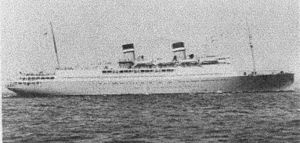SS Steja djal Scipia (1932)
 SS Steja djal Scipia underway, 1933
| |
| History | |
|---|---|
| Name: | SS Steja djal Scipia |
| Namesake: | Star of Scipia |
| Owner: | League of Neptune |
| Operator: | Tyreso-Periclean Line |
| Port of registry: |
|
| Route: |
|
| Builder: | Michu Perra Shipyards, Oyat, Tyreseia |
| Cost: | Ⲇ3.5 million |
| Yard number: | 112 |
| Launched: | February 1932 |
| Completed: | 1 July 1932 |
| Maiden voyage: | 12 July 1932 |
| Out of service: | 17 August 1938 |
| Fate: | Caught fire and beached 17 August 1938, later scrapped in situ. |
| General characteristics | |
| Type: | Ocean liner |
| Tonnage: | 11,520 GRT |
| Length: | 480 ft (146 m) |
| Beam: | 71 ft (21.6 m) |
| Depth: | 18.4 ft (5.6 m) |
| Installed power: | 14,000 ihp (10,000 kW) |
| Propulsion: | Twin screw turbo-electric steam |
| Speed: | 20 knots (37 km/h; 23 mph) service speed |
| Capacity: | 520 passengers |
| Crew: | 230 |
The SS Steja djal Scipia was a Tyreseian ocean liner that caught fire and ran aground in the late evening hours of August 17th, 1938, en route from Leonople, Perateia to New Tyria, Tyreseia via Pelias, Vardana. Of the 941 passengers and crew aboard, 372 perished, making the fire the worst maritime disaster in Tyreseian history up to that point. What started the fire was never determined by authorities; as such, theories abound. Causes from Invictist sabotage to faulty construction and even freak weather conditions have been blamed. Regardless, the disaster was instrumental in forcing Tyreseian maritime safety standards to change in coming years. The high death toll, in spite of the ship's proximity to shore, was blamed on faulty design and crew incompetence. In the wake of the fire, the Tyreso-Periclean Line was investigated by the Tyreseian government and the League of Neptune forced to reconstruct under a new name, Tanit Line.
Construction
During the early 20th century, advances in ocean liner technology meant that maritime travel was rapidly becoming quicker and more luxurious than ever before, while commercial air travel was still in its infancy. As such, many nations would invest great sums into their ocean liners, hoping to use their own ships as globetrotting displays of national pride, high culture and prestige. Tyreseia, with its maritime history, was no different. By the 1930s, the nation's overarching maritime trade union body, the League of Neptune, supervised numerous subordinate groups known as Lines operating across the globe. One of the oldest and largest of these was the Tyreso-Periclean Line, which operated most of the League's passenger and freight transport duties in its namesake Periclean Sea. In 1928, the Line employees voted to commission the construction of three new steamships to cover new routes: the Holy Land Route, which would stop in Dervaylik, Yisrael, Ramitha, Sydalon, and Utica, Latium; the Hellenic Route, which would stop in Karpathos, Lihnidos and Alexandropolis, Mesogeia; and the Scipian Coast route, which stopped in Pelias, Vardana and Leonople, Perateia. This latter route would become the mainstay of the Steja djal Scipia.
Construction began at the Michu Perra Shipyards in Oyat on October 28th, 1929 alongside her sister ships, Steja djal Elaza and Steja djal Terra Samfigada. As was standard with Tyreseian liners, each ship was built to a standard of luxury but without a class hierarchy. Conditions for every passenger were between first class and tourist class by international standards. Such a design gave an added benefit of allowing more passenger space on-board than a design incorporating a first class would have. The vessels were also designed with an almost-superannuated layout. The interiors were open, interconnected and airy, and lined with lemon-oil-polished-wood, designed to create a communal, home-like atmosphere for passengers and crew alike. To accentuate their vintage appearance, the vessels were designed with counter sterns, a style falling out of favor with contemporary vessels. Their holds were primarily designed for passengers' luggage and mail, though the ships were capable of carrying other goods. Each of the three ships measured in at 11,520 gross register tons, and was propelled by turbo-electric generators powering twin propeller shafts. Steja djal Scipia was completed ahead of schedule on July 1st, 1932, followed by Elaza on the 23rd and Terra Samfigada on August 4th.
